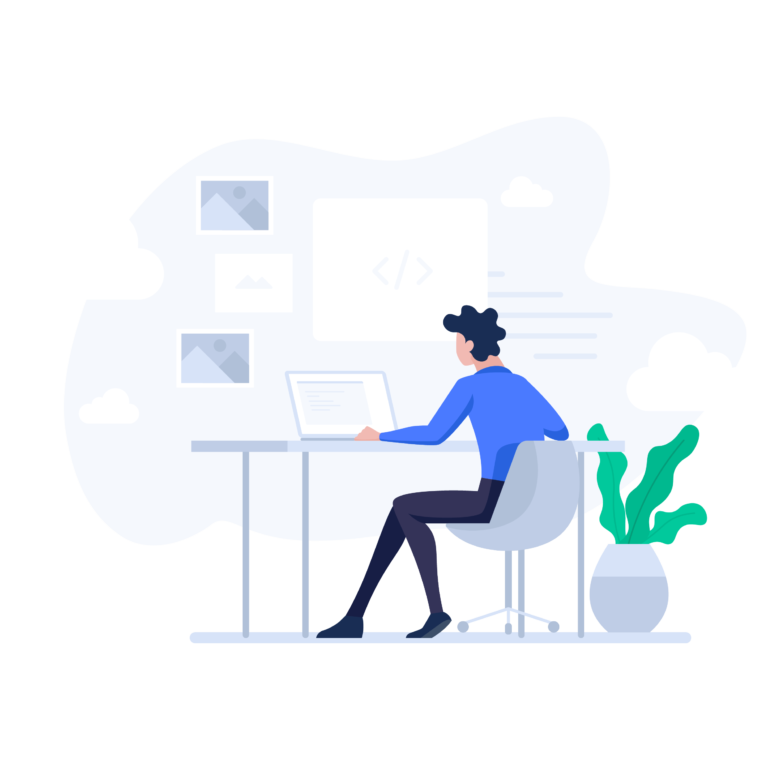- Learning How to Learn Quickly
- The Basic Process
- Learn by Doing
- How to Learn by Doing
- An Example of Learning by Doing
- How I Teach Technical Skills
- The Big Picture: What Can You Do With the Technology?
- How to Get Started
- You Need to Know 20% to Be the Most Effective
- Read What Experts Are Writing
- Practice, Practice, Practice
- Where to Go From Here
For software developers, learning is a journey, not a destination. You’ll always be able to get better — if you choose to. I’ve spent plenty of time developing my technical skills the wrong way. However, I’ve also learned how to develop technical skills at lightning-fast speed and to teach others at the same time. After all, I created over 50 highly technical developer training courses on Pluralsight over a period of about three years.
I used to think the best way to learn a technical skill was to take a big reference book and read it cover-to-cover.
Back then, I read too many 800+ page books to count and didn’t benefit much from the exercise; although my arms might have grown from carrying around books of that size.
I don’t want you to make the same mistakes I did, and if you already have, I want to show you a better way.
The following is an excerpt from The Complete Software Developer’s Career Guide by John Sonmez.
Learning How to Learn Quickly
Before we get into the specifics about learning technical skills, I think it’s worth taking a second to talk about learning how to learn quickly and teaching yourself in general.
As I mentioned, I spent a large amount of time both learning and teaching various technologies.
I learned whole programming languages in a matter of weeks and then turned around and taught courses on them.
During that process, I developed a reliable system for learning just about anything I needed to learn.
This wasn’t so much a conscious effort as it was a necessity. I was trying to learn at such a rapid rate that I had to come up with efficient ways of doing things, and naturally, patterns of learning developed which helped me to become faster and faster.
Here’s how it works.
The Basic Process
The basic idea is pretty simple.
Essentially, you want to first get a good idea of what you are learning and what the scope of it is.
You need to get enough information about your subject to understand the big picture and narrow the subject down to a small enough scope that you can actually tackle it and wrap your head around it in a realistic amount of time.
Then, you need a goal. You need to establish what it is you are trying to learn and why and, most importantly, what metric you will use to know that you’ve learned it.
Far too many people set out to learn something but have no way to measure whether they have succeeded or not.
Equipped with that starting point, you can start to gather some resources for learning.
I recommend not just reading one book cover-to-cover but to instead gather multiple resources, which may include books, blogs, podcasts, magazines, video courses and tutorials, expert opinions, etc.
Looking for resources for improving your programming skills? Check out these great links:
- Article: What’s the Best Programming Language to Learn in 2022?
- Article: 21 Steps to Becoming a Successful Web Developer
- Books: Learn to Code with JavaScript / JavaScript: Novice to Ninja
Check out SitePoint Premium for more books, courses and free screencasts.
Then, you are going to use some of those resources to create an actual plan for learning.
You are basically going to figure out in what order to learn everything you need to know about your topic.
Then, you dive in. From your learning plan, start with each module you are going to learn about your subject. For each module, learn enough to get started , play around for a bit, and then go back and answer any questions you had while playing around.
You are basically going to focus on learning by doing , which we’ll talk about in a second.
The key here is to not learn too much up front. Instead, utilize natural curiosity to drive your learning as you play around on your own. Then, go back and actually read the text or consume the content about your topic, with questions in your head and some experience which will naturally guide you to seek out what is actually important.
A big problem we face when learning by consuming a bunch of material is that we don’t actually know what is important. By playing around first and forming your own questions, you solve that problem and what you learn actually sticks.
Finally, you take what you learned and you teach it to someone else.
It doesn’t really matter the format and it doesn’t matter who you teach it to. You could talk to your dog or the squirrels in your yard if you like. Doesn’t really matter.
What matters is that you somehow reorganize the thoughts in your head in a way that communicates them to the outside world.
This is the place where learning changes from knowledge to understanding.
And that’s it.
What we have here is a basic formula you can apply to just about anything you want to learn quickly.
(If you want a more detailed example, with a workbook and videos to help you master this process, I’ve created an entire course on this approach, called 10 Steps to Learn Anything Quickly.)
Now, let’s talk more specifically about learning and developing technical skills.
Learn by Doing
I believe we all learn best by doing, but when it comes to technical skills, this is paramount.
It is just not possible to learn most technical skills by simply reading a book or even watching a video tutorial.
You may get an idea of what is possible using a particular technology, programming language, or tool, but until you’ve actually used it yourself, or solved problems with it, you are only going to have a surface level understanding.
This might be obvious for programming languages, but can you really learn how to use source control from just reading about the syntax?
If you’ve never made the mistake of merging a file into the wrong branch or checking out the wrong version of the source code, and you’ve never actually used a version history to figure out where a bug got introduced, you aren’t really going to know how to use source control — you’ll just think you do.
How to Learn by Doing
At the risk of regurgitating some information that might seem obvious, I’m going to tell you about how to actually learn by doing — consider this as a reminder for something you already know.
Whenever you are going to try and learn a technical skill, start by figuring out what it is going to help you do.
If you don’t have an immediate need for the skill, you might even question whether you need to learn it at all. A large amount of time is wasted by learning technical skills we are never actually going to use in the real world. Believe me, I’m so guilty of doing this that it’s not even funny.
You’ll have a much easier time learning something if you have an immediate application for it — a real reason to learn it.
I guarantee you will be learning like you’ve never learned before if you are being instructed on how to skydive right before you fly up into the sky and jump from a plane.
But what if you don’t have a pressing need? What if you are learning a technical skill because you want to be able to get a job where you’ll need to use it?
In that case you need to manufacture a reason to use that skill. Create a goal.
An Example of Learning by Doing
Let’s look at a real example.
Suppose you wanted to learn about relational databases and how to use them.
You could just try and read about a database and run some queries against it to play around with — and that might be somewhat effective.
What if instead your goal involved creating a database to store a collection of movies you owned?
What if your goal was to query this database, insert new movies, delete movies, update the titles, etc?
What if you wanted to create a simple application to let you access the database and do all this?
Now, you have a purpose and a way to learn by doing.
Now, you have something to do.
How do you approach learning about relational databases?
You crack open that book or you watch that video tutorial, looking for specific information you need to know to solve your actual problems.
Then, you actually create and use a database and not just as an exercise. You have a real goal.
Think about how much more information you’ll retain when you work and learn in this way.
And won’t it also be so much more fun?
How I Teach Technical Skills
As I mentioned earlier, I have taught quite a few technical skills in a pretty large variety of technologies in my day.
Therefore, I thought you would benefit from seeing how I teach technical skills to make them easier to learn. That way, you can just apply this concept when teaching them to yourself.
Make sense?
When I teach technical skills, I want to give people the biggest bang for their buck, and I don’t want to bore them with a bunch of stuff they don’t really need to know or could learn on their own when they actually need to learn it.
Instead, I focus on teaching what will be immediately valuable and giving students the resources they need to practice what I call “just in time learning” when they need to go deeper on a topic.
There are three main things I try to teach someone when I am teaching a technical skill:
- The Big Picture: what can you do with the technology?
- How to get started
- You need to know 20% to be the most effective
Let’s break each of these things down.
The Big Picture: What Can You Do With the Technology?
I always start with the big picture.
I believe in the power of Google to solve most of your problems, but you can’t Google something if you don’t know what it is.
Therefore, I first try to teach my students how big a particular technology is and what all it can do.
This is at a very surface level. I’m not showing them or you how to do everything in a technology; I’m just giving you a quick tour and overview of all the points of interest on a map.
For a programming language, for instance, I might talk a bit about the history of the language and what it is mostly used for.
Then, I might jump in and show you all the constructs of the language and the language features — especially the unique ones.
Finally, I might introduce you to the various libraries that are a standard part of the language and give you an idea of what you can do with them and what they cover.
The idea here is to give you the complete lay of the land without going into the details.
You can always look up the details on your own for the things you are interested in.
At this step, I want to eliminate the unknown unknowns. I want to make sure that you establish what you don’t have any knowledge about, so when you need to learn about it, you can know where to look.
My goal is that you don’t say, “Oh, I didn’t know X could do that,” but instead say, “I know X can do it. I’m not sure how, but I can figure that out later.”
Imagine trying to learn woodworking without knowing that such a thing as a dremel or router existed.
You don’t have to know how to use those tools, but without knowing they exist, you would be severely handicapped.
How to Get Started
The next thing I like to teach students is how to get started.
This is often the most difficult part of learning a technology — and it’s the precursor to “doing” — so I try to make this as painless as possible.
I want to show a student how to download whatever they need to download, get it installed, create their first project, and compile their code.
Once a person is able to overcome this obstacle, they can start playing around and actually building things or working with the technology.
If this barrier to entry seems too high, someone is likely to just read a book or watch a tutorial and never actually get their hands dirty.
You can utilize this in your own studies by making sure you focus on discovering how to get started with a particular technical skill early on in your learning process.
Look for specific tutorials or guides that will show you how to get started, then you can take it from there.
You Need to Know 20% to Be the Most Effective
Finally, I try to teach students 20% of the information concerning the technology that they’ll use 80% or more of the time.
Almost everything in life falls into what is called the Pareto principle, which basically states that 20% of something produces 80% of the results.
The key to learning a technical skill is figuring out what the 20% is.
What 20% can you learn that will be used in 80% of the work you do using that technical skill?
This is where it is really going to be critical to be doing rather than just reading.
Many books and even tutorials are written like reference manuals, not giving particular emphasis to the 20% of the technology that is most important to know.
If you are actively working with a technology, you’ll quickly discover what you use the most because it will be extremely painful to not know it.
Let’s look at the relational database example again.
Most likely, if you learn about relational databases, you’ll find that writing select statements is pretty squarely in that 20% area.
If you just read a book on SQL, you might find equal weight given to selecting, inserting, updating, deleting, indexing, and various other database functions.
However, if you actually try and create a database and use it, you are going to be doing a whole lot of select statements. You’ll also quickly realize that you need to learn how to join tables.
Instead of wasting your time trying to learn everything there is to know about relational databases, you’ll focus your efforts on learning how to write select statements, join tables, and other common operations that make up that critical 20%.
This is why doing is so important.
It also can help to shadow an expert and watch them work, or even assist them in an apprentice-like situation.
By just seeing someone who uses the technical skill you are developing and what their 20% is, you can learn what you need to know quickly.
On the job training especially can be extremely effective.
Read What Experts Are Writing
I’ll leave you with one final idea to help you develop technical skills.
Become an avid reader of what experts who already possess that technical skill are writing.
When I was learning my craft, I would spend about 30 minutes each day reading various blogs related to subjects I was learning about.
When I really wanted to get an in-depth knowledge of C++, I devoured Scott Meyers’ Effective C++ books.
Oftentimes, just hearing an expert’s opinion on a subject can grant you deep insights you wouldn’t be able to gather on your own.
It’s one thing to understand the syntax of a programming language or how to use a framework; it is another thing to understand the idiomatic usage of either.
Study how experts are applying the skills in the real world that you are trying to learn.
Read about the problems and arguments experts have regarding the intricacies of a technical skill, and your understanding will deepen.
Practice, Practice, Practice
Hopefully, I’ve given you a few good tips to learn your technical skills and to develop them further.
It should be pretty clear to you now that learning by doing is critical — especially when dealing with technical skills.
It should also be pretty clear to you that you need to have an actual plan to learn and a clear goal of what it is exactly that you want to learn.
I want to leave you with one final point.
Practice.
It’s going to take time to develop any technical skill. In order to get good at something, you are going to have to practice a lot.
Try not to get frustrated by how long it may seem to take, especially when you feel like you aren’t making progress.
If you put in the time, the skills will come as long as you are following a solid plan with a clear goal.
Just keep at it and trust the process.
Where to Go From Here
With the techniques I’ve covered in this post, you’re better prepared to tackle new technical skills than most of the software developers I’ve met over the last few years.
I’ve just scratched the surface, though, of the steps you can take to further your career as a developer.
In fact, I’ve put together an entire book just for developers who want to grow as professionals and earn more income while doing work they love. It’s called The Complete Software Developer’s Career Guide. For more information (and free access) click here.
If you want to expand your programming skills, check out SitePoint Premium. We have tons of books and video courses to help you on your programming journey, along with lots of free screencast. Signing up for free also gives you access to SitePoint’s famous Web forum.
John Sonmez is the author of the best-selling book, “Soft Skills: The Software Developer’s Life Manual.” He is a life-coach for software developers and regularly blogs at Simple Programmer.






